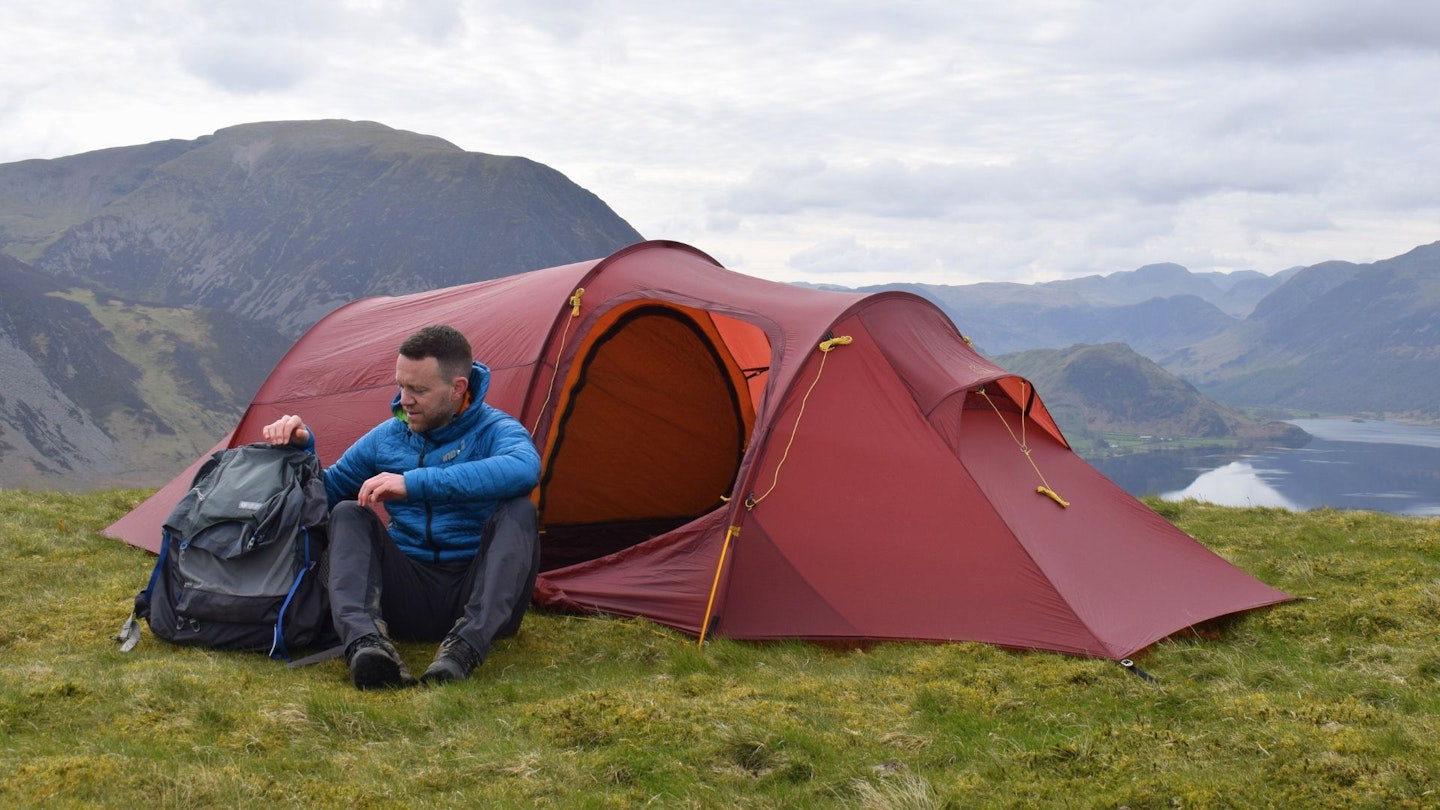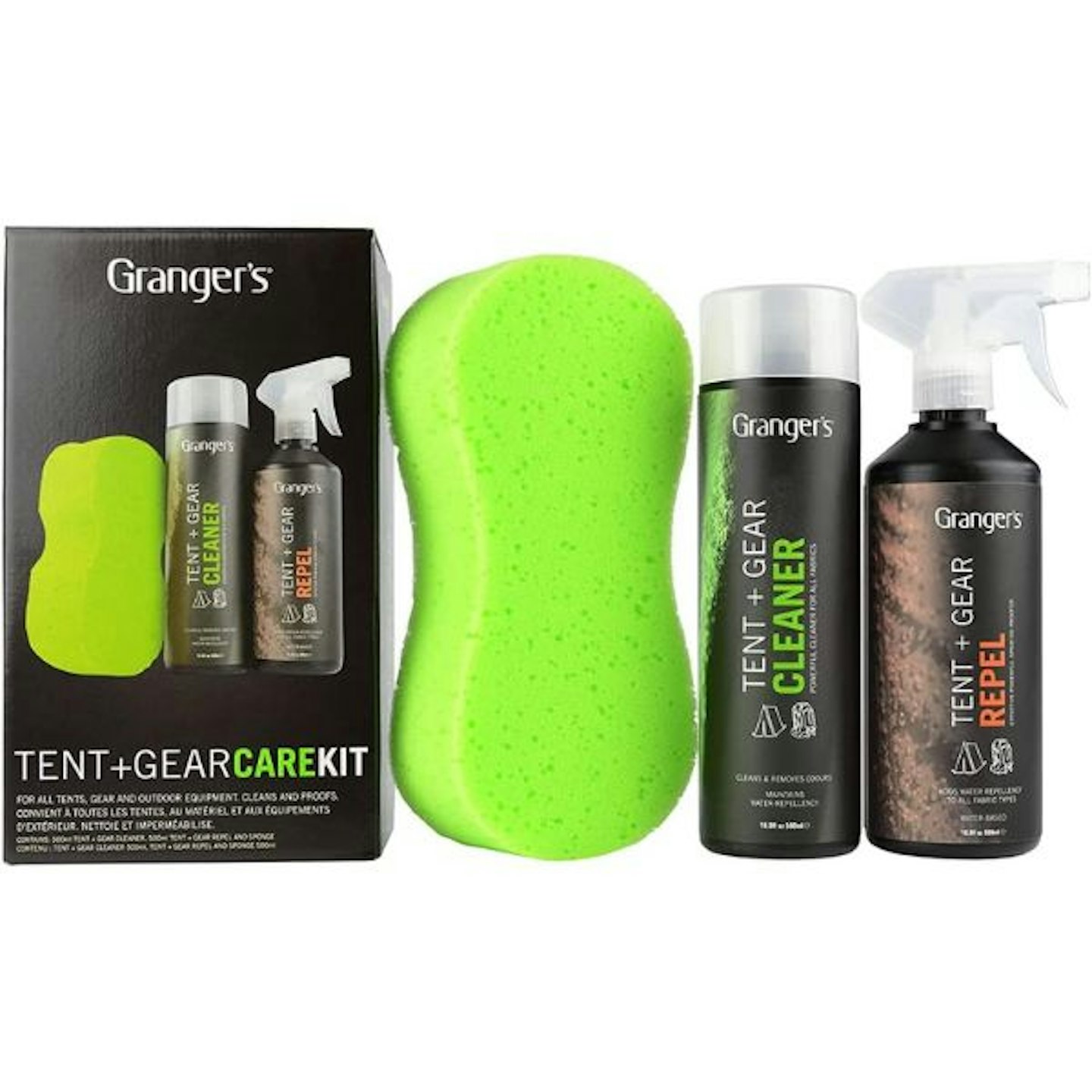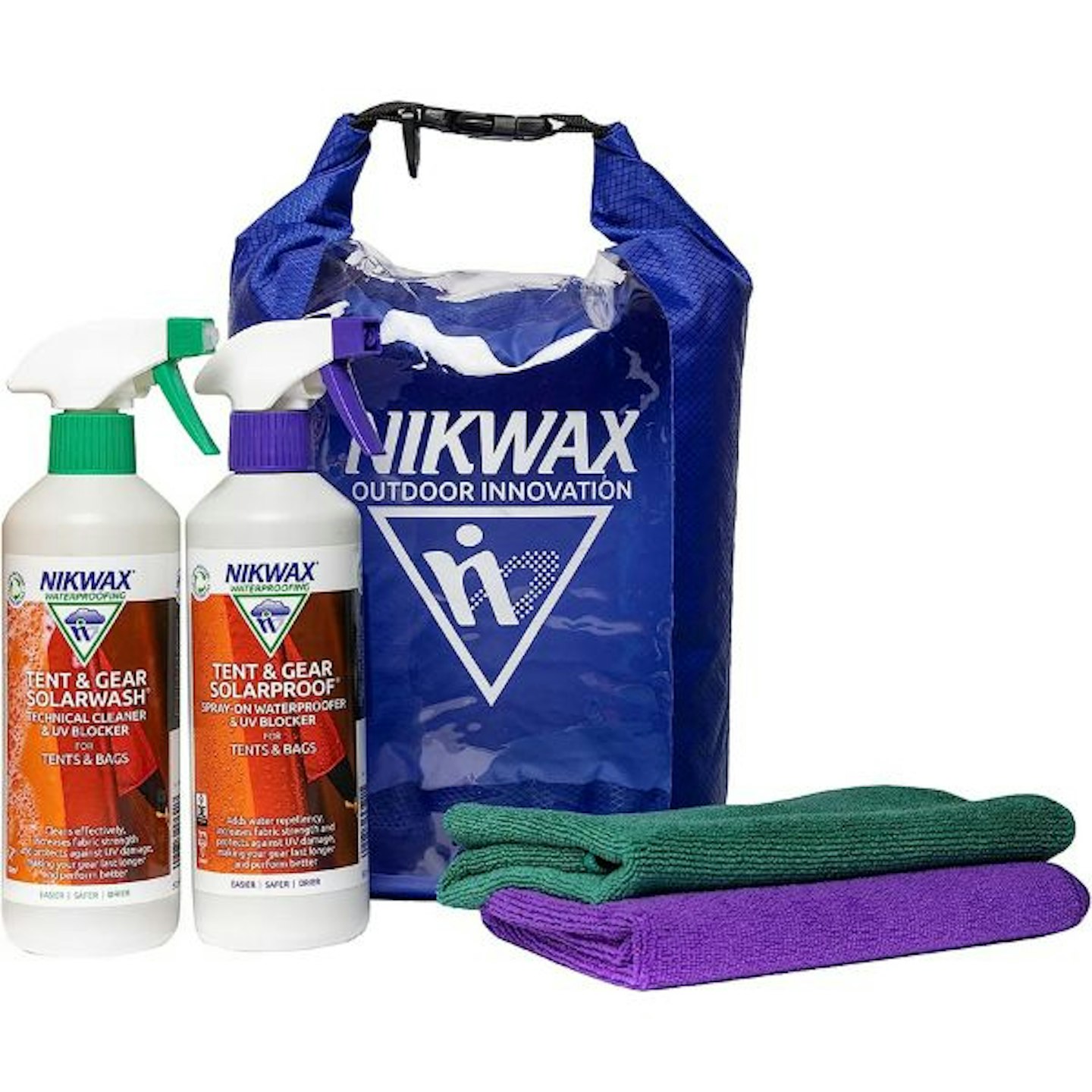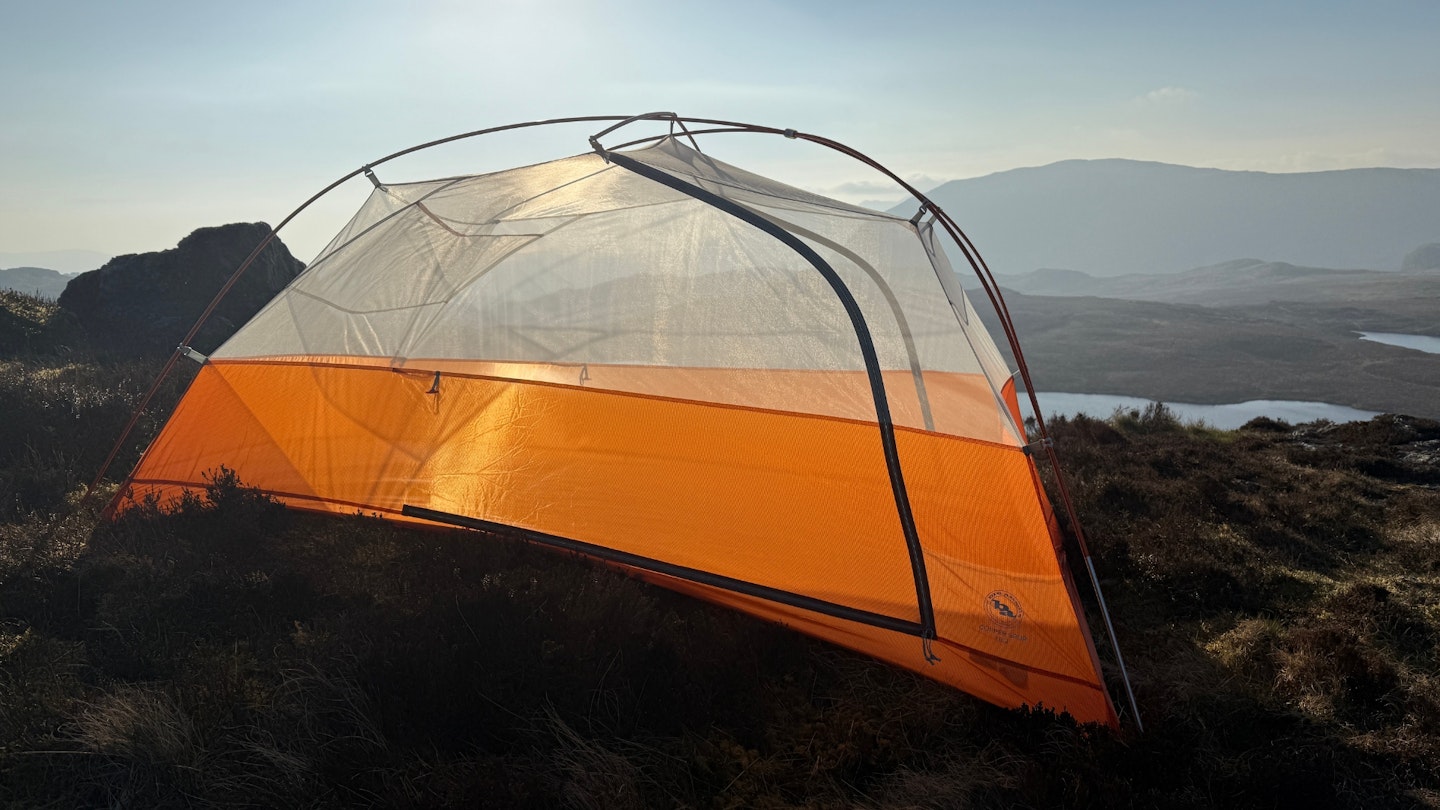In our experience, two-person tents are probably the most popular size of tent chosen by hikers, backpackers, and even bikepackers. This is because while they're obviously designed to sleep two people, solo backpackers also often favour them for the extra space on offer.
Granted, there are one-person tents if you want an even lighter, more compact shelter, or bivvy bags for the ultimate low-weight overnight experience. But for often less than 2.5kg, you can have it all with a two-person tent – sturdy weather protection, superb liveability and excellent features.
Over the decades (and it really has been decades) our outdoor writers and gear testers at LFTO and Trail magazine have used and abused hundreds of two-person tents in real-world, often gnarly conditions in the British hills and mountains.
Over that time we’ve seen lightweight backpacking tents evolve from simple tarp or dome style tents into the high-tech, low weight models you see today. But how do you choose the right two-person tent for your adventure? There’s so much to consider – weight, size, durability, features, comfort, price, and of course sustainability.
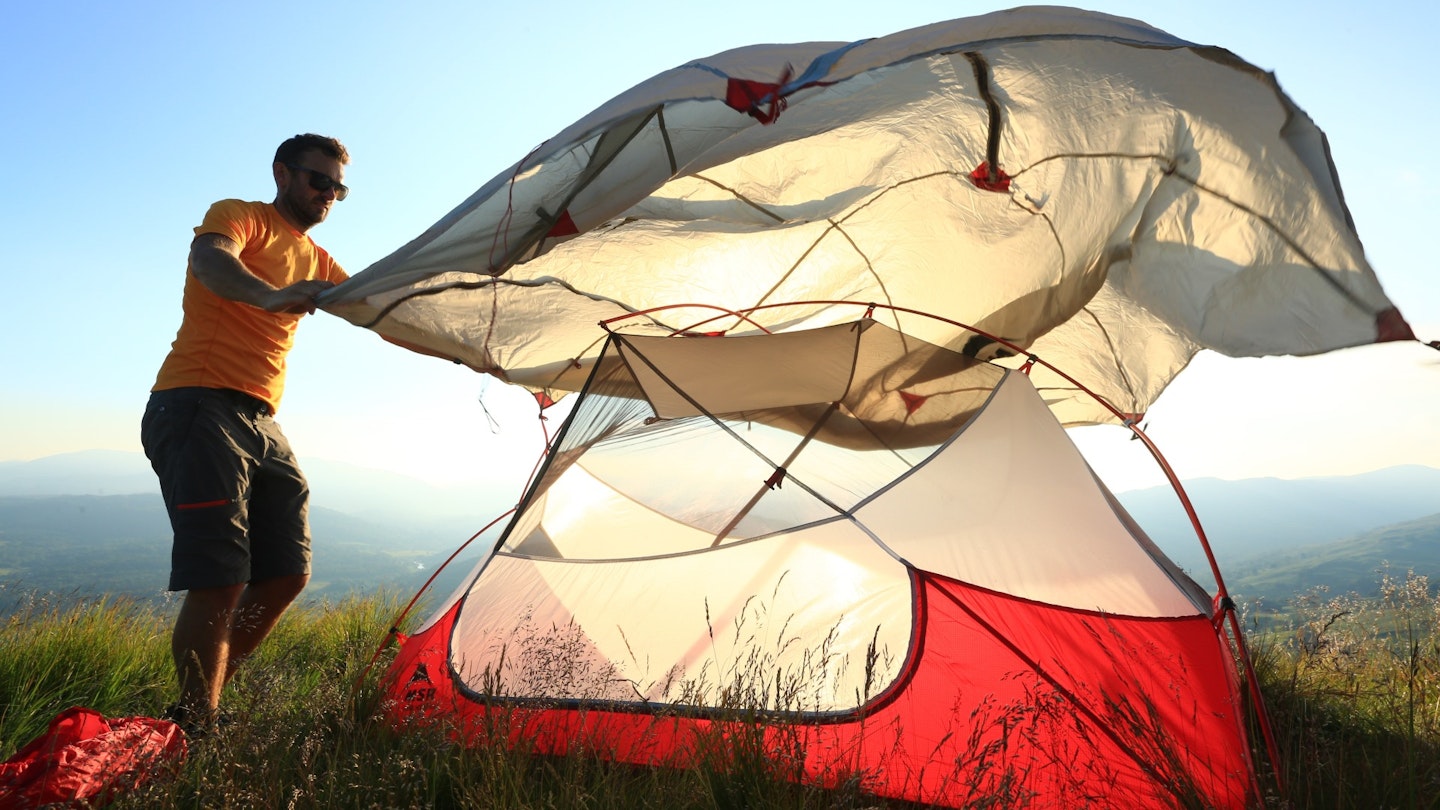
There really is a lot to think about. For example, tents with a low-to-the-ground, aerodynamic profile will shed wind better, but the most comfortable tents have roomy interiors with vertical walls and ample headroom. If you’re carrying a tent up a mountain, you’ll want it to weigh as little as possible – but the lighter it is, the less robust or more expensive it’ll be.
We’ve done the hard work for you by testing a range of two person tents in, around, and on the UK hills and whittling them down to our few favourites. We’ll be stunned if one of these doesn’t match the requirements of you and your tent-mate – whoever they may be.
What are the best two-person tents of 2025?
How we tested the best two-person tents
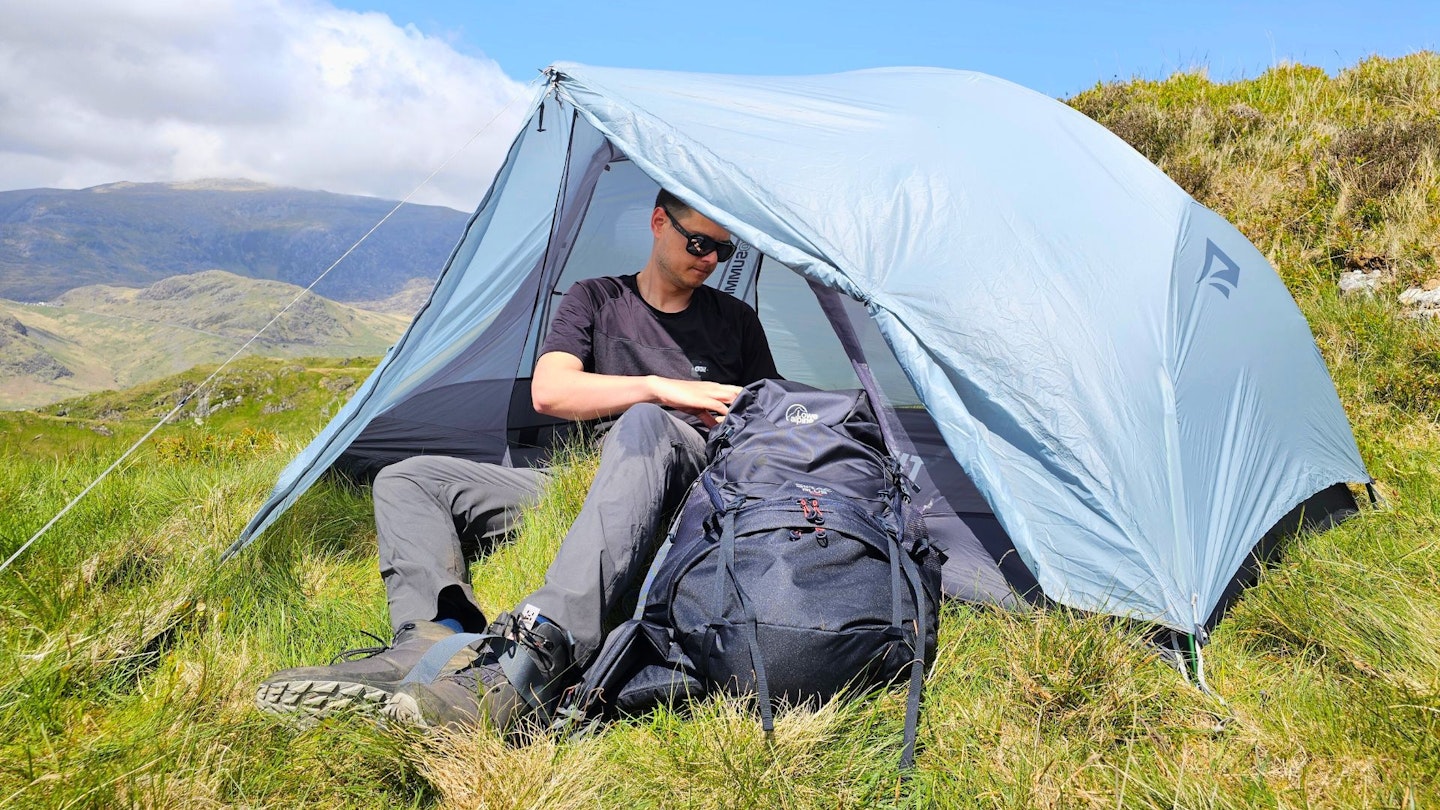
We take our test tents out on proper excursions. Two-person hiking tents we tested spent many hours pitched on hillsides. We, of course, use them for sleeping in on our trips, but we also spend a lot of time examining every detail about them, from living space and ease of pitching to material quality and sustainability.
The two-person tents recommended here were tested by James Forrest and Matt Jones – two of the UK's leading and most experienced outdoor writers. James is our Lake District-based freelance writer who is a highly experienced backpacker and wild camper.
Matt is a former outdoor magazine editor and now a freelance journalist based in the heart of Snowdonia National Park. He is one of the most well known and experienced outdoor writers in the UK.
Read more about how we test.
The best two-person tents reviewed:
We reviewed the 3-person Dagger OSMO last year, and endorsed it with both thumbs. The OSMO is a long-standing model, and this latest 'Ridge' edition is the most refined version we've ever seen.
The most obvious update is a roomier shape, with taller doors, a higher peak, and wider vestibules – all without significantly bumping up the weight. It's still sub-2kg, but now has 109cm of headroom, 223cm length, and a fully rectangular floorplan with near-vertical end walls. Internal space is excellent, and you can easily get two wide mats side by side.
The tent’s standout fabric – NEMO’s own OSMO ripstop – is now even more waterproof, with 3,000mm HH on both fly and floor. It also stretches less than sil-nylon, and doesn't sag in the wet.
The Ridge also swaps in all-metal tensioning hardware and adds extras like the waterproof ‘Landing Zone’ porch gear tub, Nightlight Pockets, and intuitive one-handed door toggles.
It’s not ultralight or the cheapest around, but it balances liveability, build quality, and all-weather versatility better than most. For UK backpackers and wild campers, it’s an ideal mix of comfort and performance for three-season use.
Read our full Nemo Dagger Ridge OSMO 2P Tent review here.
Pros
- Excellent internal space and headroom creates a genuine 2-person tent
- Good waterproof performance thanks to upgraded OSMO fabric
- Great build quality and premium materials
- Generous vestibules with innovative waterproof Landing Zone
- Lightweight and compact for its class
- Practical features like Nightlight Pockets and one-handed door toggles
Cons
- Not cheap for a three-season backpacking tent
- Inner-pitch-first design isn’t ideal for wet-weather setup
- Slightly narrower than some competitors (127cm width)
- A bit fiddly to attach fly to centre spreader bar
| RRP: | £560 / $499.95 |
| Internal dimensions: | (L x W) 223 x 127cm |
| Peak height: | 109cm |
| Packed size: | 51 x 16cm |
| Trail weight: | 1.9kg/4.8lb 3oz |
| Doors: | 2 |
| Porches: | 2 |
| Design type: | Freestanding |
| Materials: | Fly: OSMO Ripstop (3000mm HH), Inner: 40D nylon/ No-see-um mesh, Floor: OSMO Ripstop (3000mm HH), Poles: DIAPOLE anodised aluminium |
The Vango Apex Compact 200 is effectively the popular Vango Nevis 200 with an eco-friendly upgrade. It’s made from the new and upgraded Protex Eco fabric, which is a 70-denier polyester made from recycled single-use plastics, and is part of Vango’s Earth Trek Collection.
The Apex Compact 200 is a solid option – unbeatable at this price, we reckon – with a proven design, clever features and impressive stats. We found it’s comfy enough, but it is 'cosy' for two people and not as spacious inside as some of the other two-person tents we tested.
In terms of weather resistance it copes reasonably well in windy conditions – it has a relatively low-to-the-ground profile, the tunnel shape is aerodynamic with wind flowing over it smoothly without buffeting, and the structure feels pretty sturdy and stable.
The Apex Compact 200 also boasts impressive hydrostatic head ratings. The Protex Eco flysheet has a 3,000mm hydrostatic head rating, while the inner’s groundsheet (which does not feature recycled materials) is rated at 6,000mm.
While the weight makes it a bit heavier than some of its significantly pricier competitors, at just over 2kg it seems reasonable considering the affordable price-point. All-in-all the Vango Apex Compact 200 is an affordable, entry-level tent with a proven design and good features.
Read our full Vango Apex Compact 200 review.
Pros
- Very affordable
- Proven design
- Stable structure
- Vango sells spares and offers repair service
Cons
- Not the roomiest
- Heavier than premium rivals
- Lower quality than more expensive rivals
| RRP: | £145 |
| Type: | Tunnel |
| Weight: | 2.2kg / 4lb 13.6oz |
| Packed size: | 30 x 20cm |
| Doors: | 2 |
| Inner: | Polyester |
| Fly: | Recycled 70D Protex Eco (3000mm HH) |
| Groundsheet: | 70D polyester (6000mm HH) |
| Poles: | PowerLite 7001-T6 alloy |
| Vestibules: | 1.5 |
We've been big fans of MSR for a while now – especially their 2-person offerings like the MSR Tindheim 2 which won 'best tent' in our Gear of the Year awards last year. The US brand has once again impressed with this solid all-rounder.
It isn’t the lightest or sleekest tent on the market, but what the Elixir 2 lacks in minimalism, it makes up for in durability, stability, and trail friendliness. It’s a freestanding two-person tent built for three-season adventures, with enough weather resistance and comfort to make it a reliable pick for wild camps or longer trips with a partner.
We found it impressively sturdy in high winds thanks to its clever pole geometry and robust 75D polyester flysheet. There are two roomy vestibules, solid waterproofing, and excellent interior space for two full-size mats — plus headroom good enough to sit up and sort gear in bad weather. Thoughtful details like colour-coded poles, glow-in-the-dark zips, and big mesh storage pockets round out the experience.
Yes, it’s heavier than its MSR stablemates, and inner-first pitching isn’t ideal in wet weather. But the Elixir 2’s balance of comfort, value and long-term reliability make it a brilliant tent for UK conditions — especially if you’re not counting grams. It even comes with a footprint as standard, extending its lifespan and boosting protection on soggy ground.
If you're not going ultralight, this is one of the most dependable tents in its class.
Read our full MSR Elixir 2 review here.
Pros
- Freestanding design is stable and easy to pitch
- Durable and robust materials throughout
- Two large doors and vestibules for easy access and gear storage
- Included footprint adds ground protection and extends tent life
- Good balance of ventilation and warmth for three-season use
- Withstands wind and rain well – very weather-resistant in real-world conditions
- Glow-in-the-dark zips and large storage pockets enhance usabilit
Cons
- Heavier and bulkier than many competitors
- Inner-first pitching can be less ideal in heavy rain
- Lower spec materials compared to higher-end MSR tents
- Basic shepherd’s hook pegs offer limited holding power
| RRP: | £360 / $320 |
| Internal dimensions (L x W): | 213 x 132cm |
| Peak height: | 104cm |
| Packed size: | 51 x 17cm |
| Trail weight: | <strong> </strong>2.82kg / 6lbs 3.4oz |
| Doors: | 2 |
| Porches: | 2 |
| Design type: | Freestanding |
| Materials: | Fly: 75D ripstop poly polyether urethane & PFAS-free DWR (1500mm HH), Floor: 75D taffeta poly polyether urethane & PFAS-free DWR (3,000mm HH), Inner: 20D nylon micromesh / 40D ripstop poly & PFAS-free DWR, 7000-series aluminium alloy poles |
If the words 'air tent' make you picture something the size of a small bungalow, think again. The Alpkit Aeronaut 2 brings inflatable simplicity to the world of lightweight backpacking.
Instead of poles, a single air beam creates the tent’s structure, making pitching as easy as a few pumps with your bike pump — yes, really. It’s quick to erect, super simple to pack down, and weighs in at a very respectable 1.5kg.
As you’d expect from a tunnel design, the interior is more sleep station than social lounge. Two people will fit – just – but it’s better suited to solo missions where weight and weather protection are key.
Waterproofing is strong, with a PU-coated 15D ripstop nylon flysheet and taped seams holding up well through sodden Welsh weather. The internal mesh and well-placed venting kept condensation at bay throughout testing.
The porch is small but usable, the pegs could be tougher, and the single entrance isn’t ideal for late-night exits. But thoughtful features like hanging loops, internal pockets, and the ability to stow the door neatly make it feel well-considered. For £199.99, this is a brilliant-value shelter for fast-and-light 3-season adventures. Just don’t forget the pump.
Read our full Alpkit Aeronaut 2 air tent review here and see our full group test of the best inflatable tents for more.
Pros
- No poles to faff with
- Can be inflated with a bike pump
- Plenty of internal storage and hanging points
Cons
- Not as liveable as some
- Porch isn't the largest
- Pegs bend easily
| RRP: | £199.99 / $279.99 |
| Weight: | 1.5kg / 3lbs 5oz |
| Packed size: | 39 x 19 x 14cm |
| Internal dimensions: | 250 x 200cm |
| Internal peak height: | 105cm |
The Copper Spur UL2 hits that elusive sweet spot between weight, comfort and liveability. At just 1.36kg, it’s one of the lightest freestanding double-wall tents we’ve tested – and it still manages to pack in solid weatherproofing, smart features and decent interior space for two.
There’s good headroom at the apex thanks to its hubbed pole design, plus two large doors and clever awning-style vestibules that can be porched out using trekking poles. Inside, we found plenty of thoughtful touches – huge overhead gear bins, internal pockets, and easy-to-use zips that make those midnight exits less of a scramble.
You do pay for the premium materials – like Big Agnes’s new HyperBead fabric – which is light, strong and PFAS-free, but also pretty thin. A footprint is highly recommended. It’s not the most bombproof tent in wind either, and the inner-first pitch isn’t ideal in a drizzle.
Still, for spring and summer use, this is a seriously appealing option. If you want a genuinely trail-worthy tent that feels more like a home than a shelter, the Copper Spur UL2 delivers – with just enough clever extras to earn its high price tag.
Read our full Big Agnes Copper Spur UL2 review here.
Pros
- Lightweight and packable for a double-skinned, fully freestanding design
- Excellent headroom
- Large, versatile vestibules with innovative awning function
- Well-ventilated for warmer weather use
- Multiple internal storage pockets and other practical features
Cons
- Premium price point
- Inferior space-to-weight compared to genuine ultralight tents such as a single-skin trekking pole shelter
- Thin fabrics require extra care (use of a footprint is highly recommended)
- Inner-first pitch not ideal in wet conditions
- Not the most wind-resistant option
- TipLok plastic hardware feels fragile
| RRP: | £549.95 / $580 |
| Internal dimensions: | (L x W) 224 x 132cm (tapers to 107cm at foot) |
| Peak height: | 101cm |
| Packed size: | 50 x 10cm |
| Total weight: | 1.36kg / 3lb |
| Doors: | 2 |
| Porches: | 2 |
| Design type: | Freestanding |
| Materials: | Rainfly/Floor: HyperBead 15D nylon with 20D solution dyed ripstop (PFAS-free), 1500mm HH. Inner: 15D nylon with 20D solution dyed ripstop and 15D polyester mesh, Poles: DAC Featherlite NFL poles |
Oppland, meaning ‘the upper countries’ in old Norse, is the Norwegian county that hosts eight of Norway’s ten highest mountains, including Glittertind and Galdhøpiggen, the loftiest of them all. Nordisk’s Oppland tents are named after this spectacular region and this title gives more than a subtle hint to their suitability for the high places.
The Oppland 2 LW is a palatial two-person tunnel tent that is similar to the MSR Tindheim 2 but takes the concept further with greater levels of weather resistance and even more space spread throughout the inner sleeping area and a humongous storage area.
This is thanks to its three-pole structure, which gives it a whopping 4.3-metre length. Considering its size, we almost couldn't believe that the Oppland 2 LW weighs just 1,737g on our scales. If that wasn’t impressive enough, it also packs down into a 40cm x 13cm sack, which compares favourably to other smaller, leading lightweight backpacking shelters.
The 20-denier ripstop nylon groundsheet is polyurethane coated and boasts a high hydrostatic head HH of 8000mm, making it very well suited to cope with our spring test outings in the Lake District and the worst conditions most campers are likely to encounter. The silicone-coated, super-light, 10-denier nylon flysheet also offers very good levels of waterproofing, with a hydrostatic head 2000mm.
Read our full Nordisk Oppland 2 LW review.
Pros
- Loads of living and storage space
- Impressively lightweight
- Compact for its size
- Easy to pitch
- Very weather resistant
- PFC-free
Cons
- Overkill for most
- Requires larger area to pitch
- Pricey
| RRP: | £990 |
| Type: | Tunnel |
| Weight: | 1.74kg / 3lb 15.2oz |
| Packed size: | 40 x 13cm |
| Doors: | 1 |
| Inner: | 15D nylon |
| Fly: | 10D nylon w/ PFC-free silicone coating (2000mm HH) |
| Groundsheet: | 20D nylon w/ PFC-free PU coating (8000mm HH) |
| Poles: | DAC Featherlite NFL |
| Vestibules: | 1 |
Worthy of its ‘Hubba Hubba’ name, this dome-like tent is definitely worthy of excitement because this popular model is a positively cavernous tent, with two doors and two big porches.
The pole structure – a single, hub-connected pole, which forks into a Y-shape at both ends and has an integrated, central cross pole – is similar to the Sea to Summit model here and creates near-vertical walls, maximum head and elbow room, and no excess fabric slack, ensuring great liveability. The inside of the tent feels palatial compared to many other tents.
The downsides are that the Hubba Hubba pitches inner first (many British campers hate this approach, fearing the inner will get wet if they are forced to erect the tent in rain), has high walls that can catch the wind on breezy nights, and the mesh interior can feel quite draughty.
But during our test camps, the Hubba Hubba NX coped well in light rain and didn’t let us down – so we aren’t overly worried about the lower-than-expected hydrostatic head ratings. It’s also reasonably low weight considering the spaciousness you get – not the lightest two-person tent we’ve ever tested, but it’s far from the heaviest either. Ultimately this tent is all about its comfy, roomy interior – if that’s what you want, it’s an excellent choice.
Read our full MSR Hubba Hubba NX review.
Pros
- Superb internal space
- Two doors
- Two generous porches
- Excellent headroom
- Good ventilation
- Lightweight
Cons
- Not suitable for use in strong winds or very wet conditions
| RRP: | £560 |
| Type: | Dome |
| Weight: | 1.7kg / 3lb 14oz |
| Packed size: | 48 x 16cm |
| Doors: | 2 |
| Inner: | 15D nylon micromesh |
| Fly: | 20D ripstop nylon w/ PU and silicone Durashield coating (1200mm HH) |
| Groundsheet: | 30D ripstop nylon w/ PU Durashield coating (3000mm HH) |
| Poles: | DAC Featherlite NFL |
| Vestibules: | 2 |
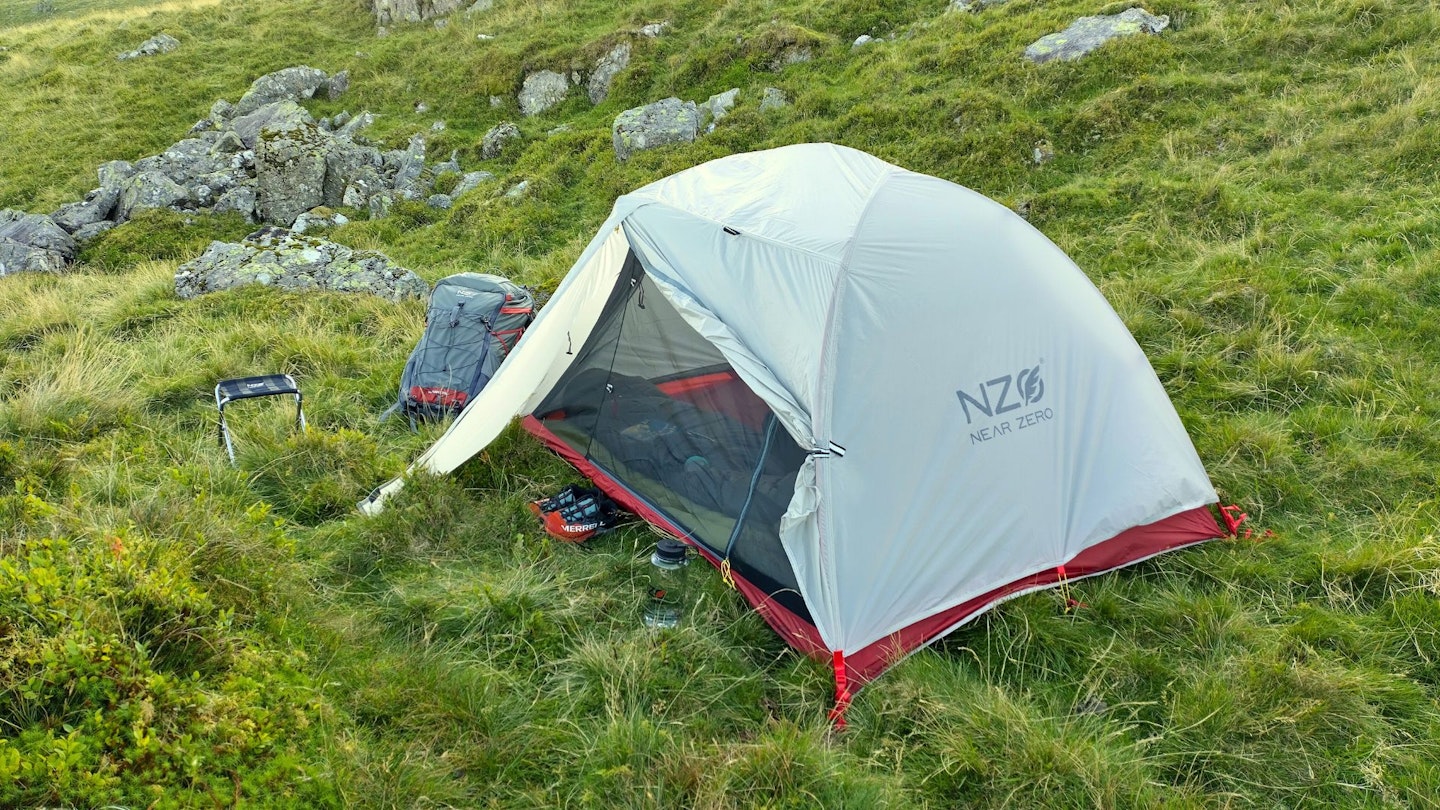 LFTO
LFTOnearzero.co
You may not have heard of Near Zero before. It's quite a new outdoor brand that's based in Arizona and focuses on making kit that is designed for ease of use and to be affordable, with the ultimate goal of making overnight hikes more accessible to more people.
We like that mission statement, and we like the gear that's come from Near Zero as a result. We tested one of its hiking bundles over a summer and were very impressed with much of it, including the tent.
As a lightweight tent for summer backpacking trips and hikes, there's lots to commend the Near Zero tent for, not least because of the price. At just 1.79kg this is a super lightweight model, which also packs down very small. Yet it offers excellent liveability, thanks to two vestibules and doors and cross section in the pole that gives more headroom inside.
The inner is full mesh and the fly and floor are both 20D nylon. It's therefore not the toughest tent and isn't the most weather resistant either. Sure, it'll happily fend off a bit of vertical rain but the fly doesn't extend all the way to the ground meaning draughts and even some moisture can reach you.
The flipside of course, is that ventilation is superb, and if you get lucky with a warm night, you can stargaze unobstructed by removing the fly.
Read our full Near Zero Bundle review.
Pros
- Good value
- Lightweight and compact
- Two porches
Cons
- Not the most weather resistant
| RRP: | £222 / $299.50 |
| Type: | Dome |
| Weight: | 1.79kg / 3lb 15oz |
| Packed size: | 48 x 11.4cm |
| Doors: | 2 |
| Vestibules: | 2 |
| Fly: | Silicone and PU-coated 20D nylon (3000mm HH) |
| Groundsheet: | Silicone and PU-coated 20D nylon (3,000mm HH) |
| Poles: | Aluminium |
| Inner: | Nylon mesh |
Alpkit’s Ordos 2 is a lightweight backpacking tent for when low weight and an affordable price are a high priority. It weighs in at just 1,521g, thanks to its minimalist design and use of lightweight 15 and 20-denier fabrics.
It has a hybrid tunnel design, with one long ridge pole linked to a large front hoop and smaller rear cross pole via hub connectors. We found this semi-geodesic, wedge-like shape resists wind effectively, while both the waterproof flysheet and groundsheet have a decent 3,000mm hydrostatic head rating. The fly has an integrated vent to help with airflow and four guylines for stability. At the head end there is a single door and small porch.
Better still, in true Alpkit fashion, the Ordos 2’s price tag compares favourably to similar tents in terms of price point. Admittedly, it’s not cheap, but then this is a high-quality shelter and you can expect to pay around twice as much for a tent of comparative calibre from the likes of NEMO, Sea to Summit or MSR.
It’s a less spacious inside than some, while it tips the scales a little more than the very lightest of lightweight shelters, but for this price these qualms seem positively ludicrous.
Read our full Alpkit Ordos 2 review.
Pros
- Wonderfully lightweight
- Great value
- Small pack size
- Wind-resistant shape
- PFC-free
Cons
- Tent footprint sold separately
- Less headspace than some other tents
- Only one vestibule
| RRP: | £219.99 / $309.99 |
| Type: | Semi geodesic |
| Weight: | 1.52kg / 3lb 5.5 oz |
| Packed size: | 13cm x 42cm |
| Doors: | 1 |
| Vestibules: | 1 |
| Fly: | 15D ripstop nylon w/ PFC-free silicone and PU-coating (3,000mm HH) |
| Groundsheet: | 20D ripstop nylon w/ PFC-free silicone and PU-coating (3,000mm HH) |
| Poles: | 7001-T6 / upgradeable to DAC NSL Green (550g alloy) |
| Inner: | 20D polyester mesh |
What to look for in a two-person tent
What tent shape is best?
Tunnel tents and geodesic tents are the most stable shapes and best for dealing with stroppy weather. The latter are the best for use in winter and the harshest conditions but are also the least spacious inside and heavier thanks to more poles and often tougher fabrics. Tunnel tents are very popular because they can be compact and lightweight, yet quite spacious and weatherproof too.
Dome tents are a common sight too, and vary quite a lot in design. They benefit from being freestanding and some are very stable. That said, there are certain dome tents that are less suited to strong winds because they have more upright walls to boost internal space, but at the expense of some stability.
What is the ideal weight and packed size for a two-person tent?
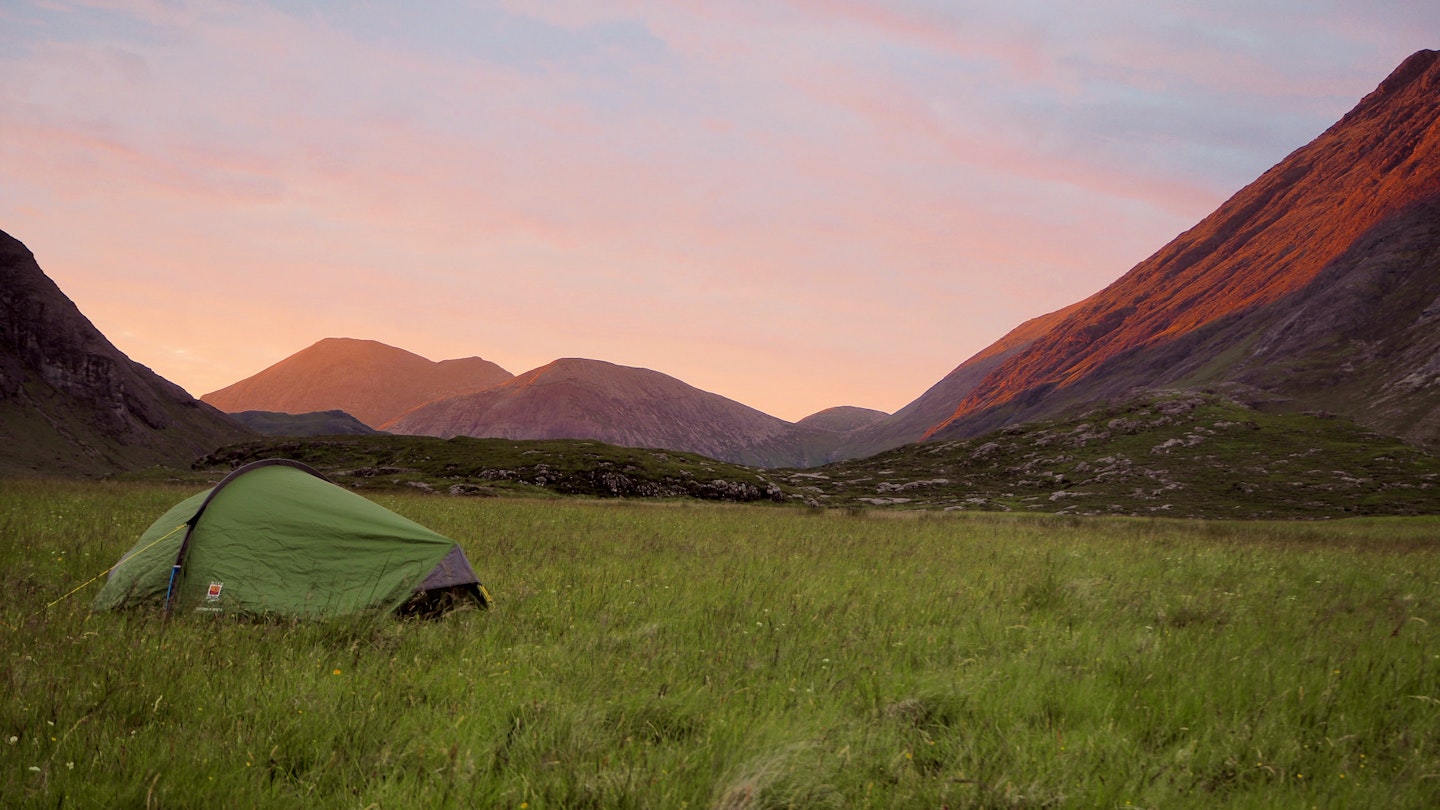
When it comes to lightweight tents, users often size up especially for longer trips because of the extra space available in return for a marginal size and weight increase. So, a solo backpacker will often treat themselves to a two-person tent; a pair upgrade to a three-person tent, and so on.
Ultimately, consider your rucksack size and volume, and be sure to check dimensions of a tent's packed size before committing to it. For a good quality, 3-season tent, 1kg or under is extremely light, 1.5kg is good, and more than 2kg is a tad on the heavy side.
How much internal space should a two-person tent have?
For two people to fit, you want a minimum of 60cm of shoulder width per person and a length of at least 2.1 metres. Some tents are asymmetric and are narrower at one end than the other. In terms of height, at least a metre allows you to sit upright, and for vestibule space, well, the more the better.
Do two-person tents pitch differently?
Some tents, particularly from US brands, are pitched inner first because they are best suited to warmer conditions and often used without the flysheet. But, it isn't ideal if it's raining. Others are pitched outer first or all-as-one, enabling the inner to be kept dry while the flysheet is pegged out.
Whichever design you opt for, rest assured that tents these days are all easy to pitch thanks to simple innovations like colour coded poles. It's been a few years since we've come across a backpacking tent that was tricky to pitch.
How do I ensure my two-person tent is weatherproof?
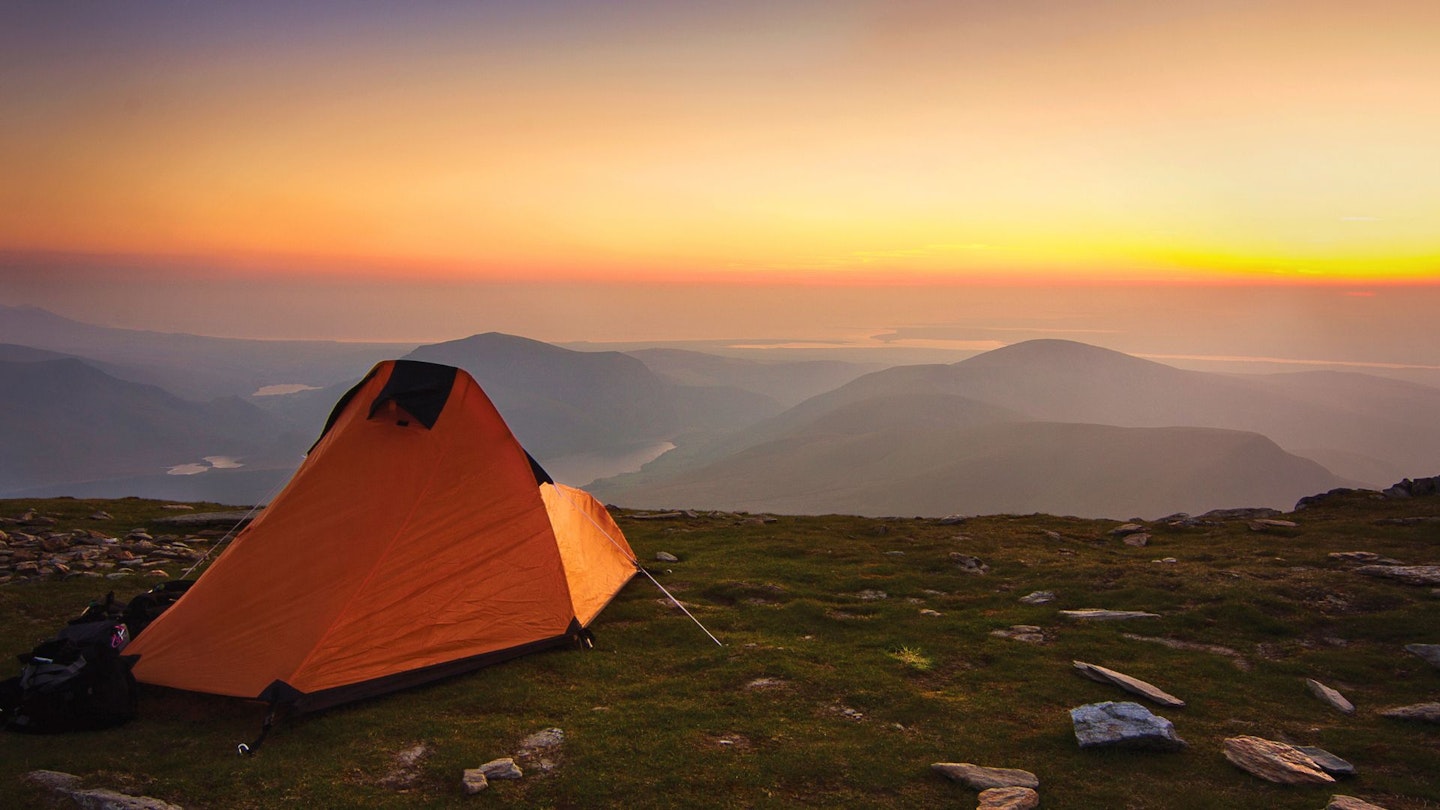
In addition to the overall shape, which we've mentioned above, for an indication of how waterproof a tent really is, check the hydrostatic head of the flysheet and groundsheet. A lot of lightweight tents' waterproof ratings may seem disappointingly low. However, many other factors, including silicone or PU coatings, the tent's shape, sealed seams, and the tightness of a fabric's weave, affect waterproofing.
As a rule of thumb, however, 2,000mm HH for the flysheet and 4,000mm HH for the groundsheet are good baselines for a tent if you're expecting to encounter heavy rain on your adventures. You can also boost underfloor water resistance with the use of a tent footprint.
Another key component of a tent's weather resistance is the flysheet.
For maximum weatherproofing, a tent's flysheet – the waterproof outer – should peg out flush to the ground and be easily adjustable via tension straps so that it's taut, stable and well-shaped. Some flysheets don't quite reach the ground, which aids ventilation but risks water ingress and draughtiness.
Why is ventilation important?
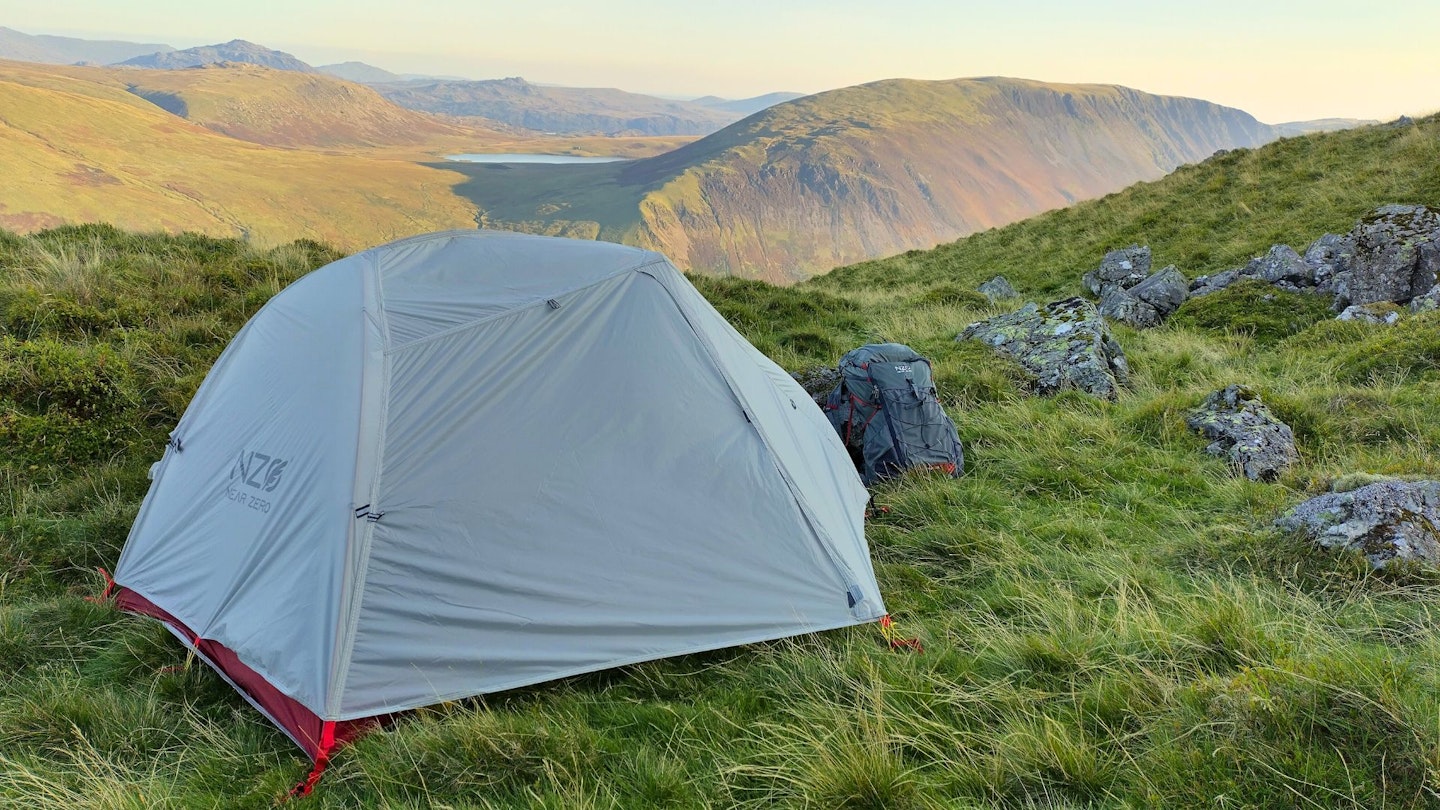
Condensation can be difficult to avoid in humid and wet climates, so good ventilation is key. Mesh vents on the inner and vent windows on the flysheet will help increase airflow, as will mesh panels on the inner's walls. Good clearance between the inner and outer is very important too.
What other features should I consider?
Other important features include: a good-sized porch for stashing your backpack and boots, a wide door for easy entry and exit, sufficient length and width for lying down (check carefully if you're 6ft+), a stormflap over the main zipper, internal pockets for gear organisation, an easy-to-fill carry bag, strong poles, good pegs, sturdy pegging out loops and robust guy lines.
How do I clean my tent?
To maintain the performance and waterproofing of your tent, you need to care for and clean them properly. You wouldn't reasonably expect longevity out of anything that isn't cared for.
Tent cleaning and care is easy and primarily involves cleaning them after use with the correct cleaning products and making sure they're completely dry before storing them away.
If your tent is in need of a repair, get in touch with a specialist repair agent such as Lancashire Sports Repairs, or the retailer/manufacturer. Outdoor gear repair services are continually improving as both brands and customers aim to be more sustainable (repair is also much cheaper than replacing).
You can also waterproof a tent yourself if the seams or fabric starts leaking.
Grangers' effective and eco-friendly care kit for tents and outdoor gear such as packs. It even comes with a sponge to help apply the Cleaner solution. The Cleaner and Repel are available to buy individually too.
Pros
- Water-based and PFC-free
- Easy spray-on water repel
- Good value
Cons
- Reproofing spray needs applied quite regularly
Nikwax's tent and gear care kit. It's just as good as the Grangers kit and also water-based and PFC-free. SolarWash and SolarProof are available to buy individually.
Pros
- Water-based and PFC-free
- Dry bag included
Cons
- Reproofing spray needs applying quite regularly
About the authors

James Forrest is a prolific peak bagger and long-distance walker who’s one of the most high-profile outdoor writers in the UK. He writes regular features and route guides for Trail and has been one of our main gear testers for the last few years.
Matt Jones is a dedicated long-distance walker who's also a very respected voice in the outdoor industry. He's previously edited both Walk and Scouting magazines, and has been reviewing gear for years, including for Trail magazine and LFTO.






